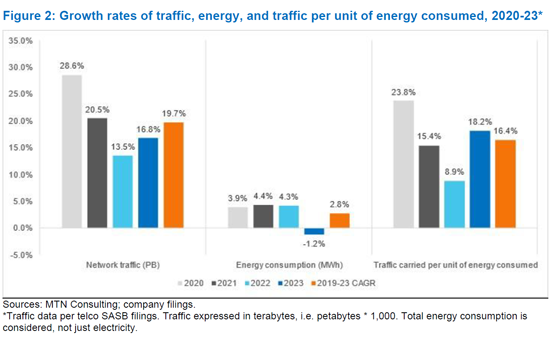
|
시장보고서
상품코드
1688514
친환경 네트워크 - 트래픽 효율성을 강화하는 통신사Greener Networks - Telcos Power Up Traffic Efficiency: Telcos Consumed 15.4% Less Energy in 2023 per Petabyte of Traffic Carried than 2022, Emissions and Renewables Adoption Remain Dismal |
||||||
2023년 후반, MTN 컨설팅은 통신사 네트워크의 트래픽 증가와 에너지 소비의 관계에 대한 초기 검토를 발표했습니다. 이 리뷰는 16개 통신사 데이터를 포함했으며 2020-2022년 데이터에 중점을 두었습니다. 이번 갱신판에서는 대상 통신 사업자를 30사로 확대되어 2년간(2019년, 2023년)의 데이터를 추가했습니다. 당사의 분석은 2019-2023년의 시간 프레임을 다루었습니다.
비주얼

본 분석에 포함된 30개 사업자 그룹은 수익 기준으로 세계 시장의 약 55%를 차지합니다. 2023년 통신사는 수익 미화 100만 달러당 평균 2.06페타바이트의 트래픽을 전송하여 2019년 100만 달러당 1.00페타바이트의 2배 이상이 되었습니다. 이와 같은 것이 가능한 것은 통신사업자가 보다 저렴하게 트래픽을 전송하는 것을 목적으로 한 끊임없는 개선을 실시하고 있기 때문입니다. 에너지는 비용의 큰 부분을 차지합니다. 그렇다면 네트워크는 단위 소비 에너지 당 트래픽 운송에서 더 효율적입니까?
2019년부터 2023년 사이에 통신사업자 30개사는 네트워크 트래픽을 CAGR 19.7%로 증가시키고 총 에너지 소비량은 CAGR 2.8%로 증가했습니다. 그 결과 2023년 통신사업자의 에너지 소비량은 평균 90.0MWh/PB로 2019년 165.5MWh/PB에서 감소했습니다. 이는 페타바이트당 MWh의 연평균 개선율이 CAGR 14.1%임을 의미합니다. 즉, 통신 사업자가 전년도와 동일한 트래픽 부하를 전송하는 데 필요한 에너지는 평균 연간 14.1% 적습니다. 이러한 개선은 네트워크의 에너지 효율을 장기적으로 개선하는 통신 사업자와 그 공급업체의 목표를 따릅니다. 2019년 이후 MWh/PB의 지표가 가장 개선된 것은 BT, Entel, Rogers, Tele2, Veon입니다.
대상 범위
게시 조직
|
|
목차
- 요약
- 통신 네트워크의 에너지 효율 : 연간 14% 향상
- 데이터 세트 : 개요
- 지속되는 수익과 트래픽의 어려움
- 소비 에너지 단위당 트래픽 처리량
- 개선 지속에 중심적인 역할을 수행하는 공급업체
- 총론
- 부록
In late 2023, MTN Consulting published an initial review of the relationship between traffic growth and energy consumption in telco networks. That review included data for 16 telcos, and focused on 2020-22 data. This updated analysis extends coverage to 30 telcos, and adds two years (2019 and 2023) of data. Our analysis now addresses the 2019-23 timeframe.
VISUALS

The group of 30 telcos included in this analysis represent about 55% of the global market, based on revenues. Our data verify the well-known revenue-traffic conundrum, where traffic rises faster than revenues: in 2023, the average telco carried 2.06 Petabytes of traffic per US$1M in revenue, over double the 1.00 Petabytes per $M carried in 2019. This is possible because telcos make constant improvements aimed at carrying traffic more cheaply. Energy is a big part of the cost story. So, are networks getting more efficient in their carriage of traffic per unit of energy consumed? In the 2019-23 timeframe, our group of 30 telcos increased network traffic at an average annual rate (CAGR) of 19.7%, while their total energy consumption grew at a CAGR of 2.8%. As a result, in 2023 the average telco consumed 90.0 MWh of energy per Petabyte of traffic, down from 165.5 MWh/PB in 2019. That works out to an annual average (CAGR) improvement in MWh per Petabyte of 14.1%. Meaning, on average, telcos need 14.1% less energy per year to carry the same traffic load as the prior year. This improvement is in line with the stated goal of both telcos and their vendors: to improve the network's energy efficiency over time. The biggest improvements in the MWh/Petabyte metric since 2019 are BT, Entel, Rogers, Tele2, and Veon. The worst result came from Saudi Telecom (STC), which used 104 MWh/PB in 2023, from 90 in 2019. The poorest result in 2023 alone was reported by Vodafone, which improved (lowered) its MWh/PB ratio by just 3.8% YoY.
For climate change watchers, an important metric is greenhouse gas emissions (GHG), as measured in CO2 equivalent metric tons. We don't address emissions in this report, but we did in a December 2024 report. That report found that telco emissions in 2023 were about the same level (per unit of revenue) as in 2019, and that renewables accounted for only about 20% of energy used in 2023. Both findings were disappointing. So, this current report's conclusion is a welcome bit of good news.
Telco sustainability reports emphasize the importance of adopting energy efficient technologies and network designs. Vendors consider the energy efficiency of their solutions a crucial differentiator. As telcos attempt to lower energy costs and reduce their carbon footprints, vendors have an opportunity to support further improvements.
Coverage
Organizations mentioned:
|
|
Table of Contents
- Summary
- Telco network energy efficiency rising 14% per year
- Overview of the dataset
- The revenue-traffic conundrum persists
- Traffic carried per unit of energy consumed
- Vendors have a central role in sustaining improvements
- Conclusion
- Appendix



















